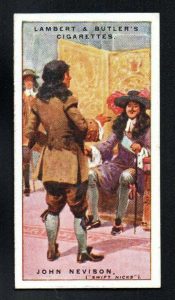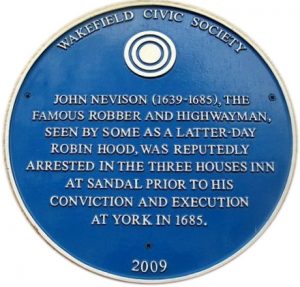John Nevison in Brief
Gentleman John Nevison is perhaps not the best-remembered of British highwaymen. However, some of his deeds and daring feats have gone down in the annals of history. In the acclaimed book series History of England, Thomas Macaulay wrote “Nevison levied a quarterly tribute on all the northern drovers, and, in return, not only spared them himself but protected them against all other thieves; he demanded purses in the most courteous manner; he gave largely to the poor what he had taken from the rich.”
It makes Nevison sound much more like a Robin Hood character than a notorious robber and murderer doesn’t it? However, do the the facts mirror the legend?

Cigarette Card depicting John Nevison from 1926
Early Life
John (aka William) Nevison was born in Wortley, near Sheffield, circa 1639. It’s thought his family were reasonably well-off, with his father either being a wool merchant or a steward at Wortley Hall. By all accounts, Nevison was a troublemaker at school and prone to stealing. He moved to London in his teens and found work as a brewer’s clerk, where he worked for several years. That was until he decided to pocket a debt he had been sent to collect and absconded to Holland.
He then joined the English army and served under the command of the Duke of York, fighting at the Battle of Dunkirk in 1658. On discharge from the army, he returned to England to look after his ailing father. By the time his father passed away, Nevison was totally destitute. With few employment prospects, it was at that point that he decided to embark on a career as a highwayman.
Nevison based himself around Newark in Nottinghamshire, targeting those travelling on the Great North Road. He soon developed a reputation as a gentleman highwayman, reputedly never using violence against his victims. It’s further claimed that Nevison, was a polite, charming man, who only ever robbed the rich.
Swift Nick
Arguably, Nevison’s greatest claim to fame is that it was he who actually made the famous horseback ride between Kent and York, that is so often credited to Dick Turpin. The famous ride took place in the summer of 1676 after Nevison had robbed a traveller at Gad’s Hill, near Rochester, Kent. It was around 4 am, when Nevison fled the crime scene, reputedly on a horse called Nutmeg, crossing the Thames by ferry, before galloping on to York, which was more than 230 miles (370 km) away. According to the legend, Nevison and his trusty steed were at one stage being pursued by three constables, who they managed to lose just outside Pontefract by jumping over a narrow gorge (now called Nevison’s Leap).
Nevison arrived in York early evening, stabled his horse at an inn, washed and changed, then had a casual stroll to a bowling green where he knew the town’s Lord Mayor was playing bowls. He engaged the Mayor in friendly conversation, even having a bet on the outcome of the bowls match. He also ensured that the time of 8 pm was brought into their exchange. All of it was part of Nevison’s cunning ploy. Later, when he was arrested for the robbery at Gads Hill, he summoned the Lord Mayor as an alibi witness in his defence.
With the Mayor’s testimony, the court simply refused to believe that a man could have committed a crime in Kent and then be in York at 8 pm on the same day. He was found not guilty of the crime, emerging from the court as somewhat of a folk hero. Nevison’s escapade reputedly even won him the admiration of the king, Charles II, who gave him the moniker of ‘Swift Nick’.
Deported To Tangiers
It is known that Nevison and his gang of six regularly met at the Talbot Inn in Newark to plan their next muggings. Their main prey were those travellers on the Great North Road, anywhere between York and Huntingdon. He was arrested in 1674 and jailed in Wakefield goal but managed to escape before any charges could be brought. In 1676, Nevison was apprehended yet again on charges of highway robbery and horse-stealing. He was tried at York Assizes and sentenced to transportation to Tangiers, after reputedly turning informer.
However, it’s reported Nevison quickly returned to England or its possible he escaped at Tilbury before the ship had even set sail. He continued with his criminal career, but in 1681, was arrested yet again. Though, once again he managed to evade justice, this time by getting an accomplice to impersonate a doctor and pronounce him dead of the plague. Another friend, an artist, applied the make-up, thus with Nevison feigning death, he was carried out of jail in a coffin. His subsequent reappearance on the outside was at first taken to be that of a ghost.
Nevison then made a major mistake when he murdered Constable Darcy Fletcher, who had tried to arrest him at Howley Hall, near Batley. A bounty of £20 was offered for his recapture. The authorities were tipped-off of his whereabouts by the landlady of a public house in Sandal (reported as either the Magpie Inn or Plough Inn), near Wakefield. Again he was tried at York Assizes, found guilty, and duly hanged at Knavesmire on May 4, 1684. His body was buried in an unmarked grave at St. Mary Church in Castlegate, York.

Mike Kirby / John Nevison Blue Plaque
The Legend Of John Nevison
While John Nevison has never achieved the same level of ongoing notoriety as fellow highway Dick Turpin, his legacy is nonetheless alive and well. The ballad ‘Bold Nevison’ was composed in the 17th century when his rip-roaring antics, especially the 230-mile dash by horseback and his escape from prison by feigning death, earned him nationwide notoriety. A version of the ballad, sung by Joseph Taylor, was recorded in 1908 on cylinder for a collection of folk songs produced by Percy Grainger.
Legends associated with the colourful highwayman, include the ‘magic well’ at Giggleswick. The myth alleges that a female spirit from the well gave Nevison a magic bridle, which enabled his horse to perform its amazing feats of speed and agility, including the prodigious jump at Nevison’s Leap. There are also still plenty of reported sightings of the ghostly Swift Nick, especially around his native Yorkshire, where he is often said to appear as a phantom hitchhiker. Today, those pubs and buildings, throughout the country, that has a connection with the famed highwayman are still very much able to cash in on the Nevison name.
So there you have it our Five Minute Overview of this fabled highwayman. We have many more in our Highwaymen range here. Anyway, before you go why not try one of our quizzes & better still why not join our growing community.





